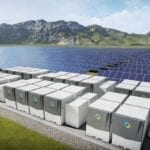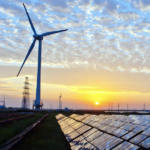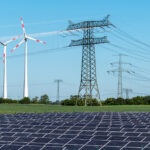Rick Tempchin, executive director, Retail Energy Services for the Edison Electric Institute, talks about the impact of distributed energy resources on utilities and their customers.
The electric power industry is transforming the nation’s electric distribution system. We’re replacing aging electromechanical technologies with an advanced digital information and telecommunications network. As we do so, we’re creating an electric superhighway for the 21st century, one that’s more reliable, secure, and capable of meeting the rapidly changing energy needs of customers. POWER Editor-in-Chief Dr. Robert Peltier, PE talked with Rick Tempchin, the Edison Electric Institute’s executive director for Retail Energy Services, who addressed the challenges of integrating distributed energy resources into today’s electric grid. Questions are presented as subheads; Tempchin’s responses follow.
What are distributed energy resources?
Among the many features that an advanced grid will offer will be a greater capability for electricity and information to move two ways: from the utility to the consumer—as it always has—and from the customer back to the utility. To take advantage of this two-way capability, more utility customers are choosing to generate a portion or even all of their electricity using distributed energy resources (DERs).
DERs can include rooftop solar panels, microturbines that provide auxiliary or backup power for a building, fuel cells, and other forms of electricity generation. DERs can also include energy storage systems, and even microgrids—a small-scale version of a utility’s centralized electricity system.
A number of factors are encouraging the growth of DERs, including falling costs of certain DER technologies—particularly solar photovoltaic (PV), smaller wind, and natural gas technologies—today’s low natural gas prices, an increasing desire to improve reliability, as well as a host of incentives for these technologies from state and federal governments.
What are the important public policy issues concerning DER deployment?
The growing use of DERs is creating opportunities and challenges for electric utilities. Integrating increasing amounts of DERs needs to be done in a way that ensures that system reliability is maintained. Because existing state regulatory and incentive mechanisms mirror the needs and workings of that system, it’s also important that increasing levels of DERs are accommodated in a way that is fair to customers with—as well as without—DERs.
The following four issues are particularly critical to ensuring that DERs are developed in a reliable, fair, and cost-effective manner that benefits all electric utility customers.
Integration Costs. To ensure that the grid remains safe and reliable and delivers quality power to all customers, the grid operator must model, monitor, and control these new DERs. These integration costs are essential for operating the system without overloading circuits, causing voltage regulation and power quality problems, or jeopardizing the safety of utility workers and the public. Because many DERs are wind and solar PV technology—and variable in nature—integration costs are likely to rise as the utility must accommodate fluctuating levels of generation from what could become a significant number of these resources in its service territory.
Although the initial costs of integrating DERs into the distribution grid may be known, the systemwide integration costs that may occur later often aren’t readily available. The final cost associated with DER integration is dependent on the level of DER market penetration, particularly with respect to systemwide grid modernization costs. Final costs may also far exceed the initially defined costs. Regulators and policymakers should be aware that the total cost of integrating DERs may have significant customer impacts over the long term.
Cost Shifting. Any incentives to encourage DERs must be fair and appropriate for all utility customers. Certain incentives, such as net metering, have the potential to shift costs from customers who own DERs to those who don’t.
The definition of net metering varies greatly from state to state, but in general, net metering programs allow DER customers to run their meters backward and get a credit for any generation they produce in excess of their own needs. As of July 2012, 43 states and the District of Columbia had a net metering policy in place.
In many of these states, DER customers can earn credit at the utility’s full retail rate for any electricity they sell back. In addition, power that these customers produce in excess of what they need during a billing cycle results in credits at the full retail rate that can be applied against their bill during later billing cycles when they’re not producing enough power to meet their own needs.
Net metering shifts costs because the full retail rate that DER customers receive for selling their power back to their utility includes the fixed costs of the utility’s distribution network—such as wires and customer service costs—costs that the utility still must recover. In cases where the utility also supplies power to the customer, the fixed costs include the costs of generating capacity built to serve the customer and that is used to provide backup service.
Because DER customers no longer contribute to fixed costs to the extent that they meet their own power needs, a utility’s remaining customers face higher rates to pay for those fixed costs.
In addition to net metering, many states are offering other incentives, including rebates, tax incentives, performance-based incentives, low-cost financing, and feed-in tariff programs. California, for example, is providing $1.9 billion in solar subsidies over the next 10 years. Again, these subsidies benefit DER customers, but are they fair to customers without DER?
Of the 43 states with net metering policies in place, 14 states also have some form of “virtual net metering,” which essentially allows credits to be applied from facilities with DERs to offset electricity consumption at multiple points that do not require a two-way meter (for example, apartments). Virtual net metering may require the use of distribution, as well transmission systems, in new ways, which may add more costs and subsidies.
Net metering also errs in treating all DERs equally, regardless of their value to the utility system. For example, DERs located in areas of a utility system with constrained capacity may reduce congestion on the distribution network and result in utility cost savings. In addition, DERs that can generate during a utility’s peak demand periods have more value than DERs that produce during off-peak periods.
Utility Participation. Whether or not electric utilities can participate in DER markets is another issue being raised. In many cases, electric utilities or their affiliates have either been prohibited from or limited in their ability to participate in these emerging markets. The concerns have been that utility participation might hinder, rather than augment, market development in the most efficient and cost-effective manner possible.
Other limitations have been put in place because of concerns raised by other DER developers. Additionally, state tax credits, grants, and loans that are available to third-party owners of DER are sometimes not available to utilities, which creates indirect barriers to utility participation in DER markets.
Although not all utilities may wish to own DERs—either on a regulated or unregulated basis—the ability to participate or partner in DER markets will not only give them an additional avenue for fulfilling their mission of providing reliable and quality electricity service at reasonable cost, but, where they serve as competitive providers of these resources, they’ll also be promoting innovation and efficiency in their development.
Backup Rates. DERs raise the question of how to handle backup electricity service as well. When customers install their own DERs, the power output won’t always exactly match their power needs. This is especially true with the variable nature of renewable DERs. Other forms of DERs, even those with steady output, aren’t always available because they may fail or be taken off-line for maintenance or repairs. As a result, DER customers must be backed up by grid-supplied power.
If the customer is connected to the grid, this backup (or standby) service is provided automatically. Regardless of who provides backup service, the provider incurs a cost by agreeing to maintain available generating capacity and not sell it elsewhere. The transmission and distribution costs incurred in providing backup service must be considered as well.
The cost, terms, and conditions of providing this backup service are key determinants in deciding the economic feasibility of DERs. During utility regulatory proceedings, it’s often been argued that backup rates are too high because utilities ignore the benefits provided by the DERs, such as deferred or avoided generation, transmission, and/or distribution capacity, reduced line losses that naturally occur along distribution and transmission lines, as well as reduced air emissions. Customers with DERs also argue that backup rates are discriminatory because they pay charges that are different from charges that apply to customers who do not self-generate.
The reality behind these claims, however, is that utilities frequently cannot defer or avoid generation due to the unreliable nature of DERs. In addition, proposed DERs often are never actually built. Utilities, however, have to account for this uncertainty.
In fact, DERs often trigger distribution and/or transmission upgrades as opposed to deferring them. Additionally, DER developers are often provided numerous carve-outs and subsidies that are not available to other systems. Lastly, backup rates are often embedded in rates of customers who do not self-generate and do not represent discriminatory charges.
Despite these facts, some states have exempted self-generators from backup service charges based on varying criteria. Other states have set backup rates in a manner that does not enable the utility provider to recover the full costs of providing the service.
Do DERs benefit all customers?
The electric utility industry shares and supports the desire of customers to adopt DERs. It’s critical, though, that it be done right. DERs must be added to the system in a way that protects reliability, ensures the safety of the public and utility employees, and is fair to all customers.
One of the key public policy issues arising from DERs is how they will affect low-usage customers (for example, apartment renters) and low-income customers—both of whom are the least likely to take advantage of DERs. Such customers are often the most vulnerable and likely will bear the financial burden of cost shifting that can occur with the increased installation and use of DERs and the associated departure of more affluent customers from the utility’s distribution system, and they should be a focus of public policy.
Looking ahead, given the many public policy issues surrounding DERs, collaborative efforts between utilities, state regulators, and customers will be invaluable in arriving at solutions that benefit each group.
— Dr. Robert Peltier, PE, POWER’s editor-in-chief, conducted and edited this interview.









